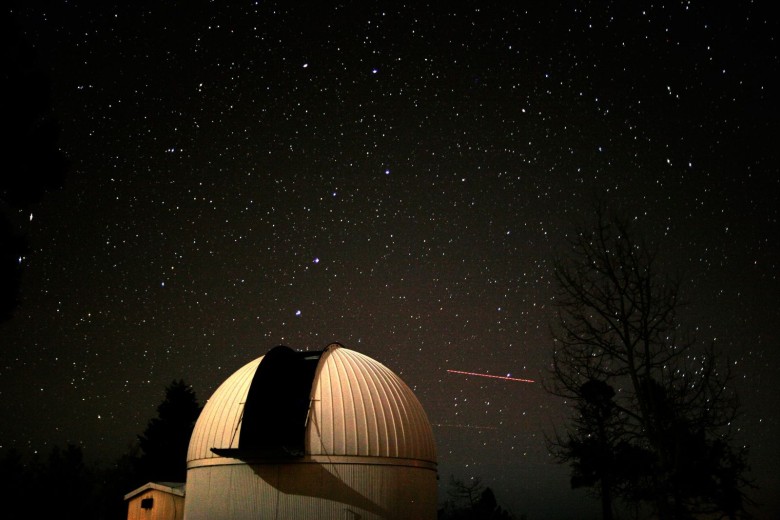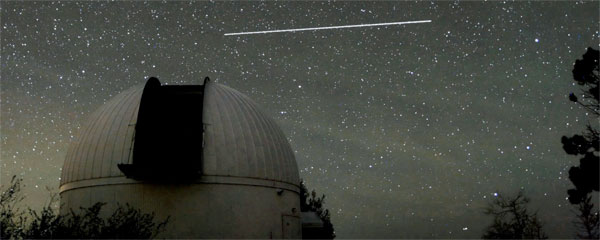Catalina Sky Survey
Catalina Sky Survey (CSS ) is to discover a project to comets and asteroids, and to search by near-Earth objects ( NEOs). Actually, for potentially hazardous asteroids ( Potentially hazardous asteroid, also called PHAs ) sought.
Assessment of the threat
The technology has since the end of the 20th century improved to the extent that one is able to systematically and automatically to a large extent Search NEOs. Since there would be catastrophic consequences for the earth after a collision with a sufficiently large object, the U.S. Congress in 1998 mandated the NASA NEO Observations Program, the program ( NEOO ) to launch to objects larger than 1 kilometer, 90 percent to capture.
Other reasons
In addition to pure information, as many NEOs there, there are other findings in the NEO project. For example, the knowledge of the asteroid belt can be improved, the cometary distribution are determined in large solar distances, etc.
Mission Objectives
Catalina Sky Survey (CSS) and the connected Siding Spring Survey ( SSS) lead the search according to NEOs and thus lead the arranged by the U.S. Congress mandate from.
Information overview
Every month cover the wide angle surveillance from the observation possibilities to about R ~ 19.5. To expand the search volume at greater distances, bigger equipment, however, are required.
So far CSS has 310 NEOs discovered in 2006 and 400 in 2005. For 2007, even going out of 450 properties found. Particularly important findings were:
Asteroid 2007 WD5
As part of the observations of the asteroid was discovered with the label in 2007 WD5 by the CSS team member Andrea Boattini on 20 November 2007. This asteroid admitted to a probability of 1:40, that he embarks on Mars. The date January 30, 2008 was called. Then the asteroid was observed more closely, to learn more information about the impact probability, creating a strike could be excluded later.
Asteroid 2007 TU24
This asteroid was discovered on October 11, 2007. The diameter was determined to be about 300 to 600 m. The asteroid crossed the orbit of the earth January 29, 2008 at a distance of 554,209 kilometers, which corresponds to about 1.44 times the lunar distance. Otherwise you know about this asteroid is not much; However, first radar observations were made so by the Goldstone Observatory on January 23.
Asteroid 2008 TC3
On 6 October 2008, the asteroid 2008 TC3 discovered and calculated that it would take place on 7 October 2008 at 4:46 CEST on the northern Sudan in the Earth's atmosphere. It thus succeeded for the first time to predict an asteroid impact on Earth right.
Asteroid 2009 KK
On 17 May 2009, the near-Earth asteroid was discovered in 2009 KK with a diameter of around 270 m, which was 22 May 2009 at the Turin assigned scale for security level 1, by further observations, the value was reduced to 0 on June 10,.
Asteroid 2014 AA
On January 1, 2014 Richard Kowalski discovered the small asteroid 2014 AA, collided on January 2, 2014 with the Earth. It was the second time after 2008 TC3 that an asteroid was observed prior to entry into the Earth's atmosphere.
Head of the CSS team is Steve Larson of the Lunar and Planetary Laboratory at the University of Arizona.
The entire team consists of astronomers:
- Steve Larson
- Ed Beshore
- Rik Hill
- Richard Kowalski
- Alex Gibbs
- Andrea Boattini
- Al Grey
In Australia:
- Robert McNaught
- Gordon Garradd
- Donna Burton
As a quasi " by-product " of the observations of this group fall at various Erstentdeckungen of comets, which either bear the name of the discoverer or in addition to the astronomical designation the additional title Catalina or even Siding Spring.










